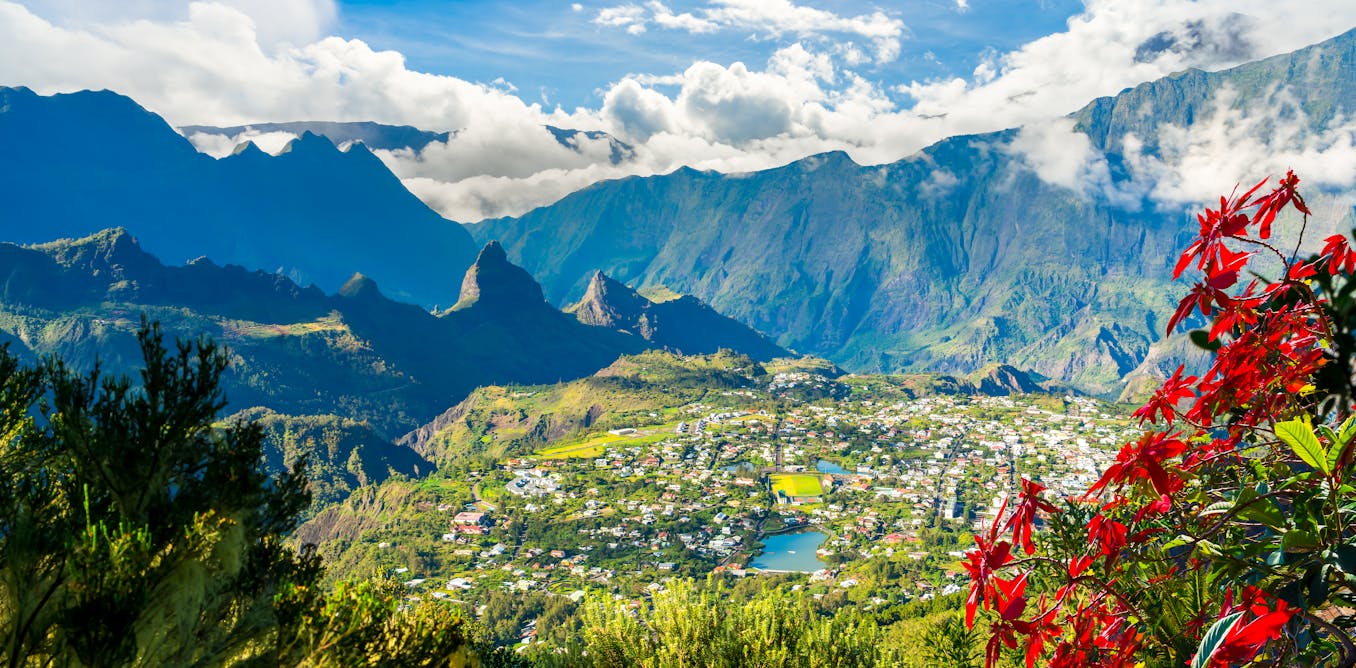You’re scrolling through Instagram, only half paying attention to your friends’ updates, when a photo of a beautiful, pristine beach grabs your eye. Somebody you know is lounging on that very beach – and suddenly you want to be there, too. You check the location tag: Réunion Island.
Réunion is a French department in the south-west Indian Ocean, situated between Madagascar and Mauritius. It ticks many of the boxes associated with a dream island holiday: beautiful green mountainscapes, waterfalls and sunny skies (and, of course, beautiful beaches). Its tourism marketing plays heavily on its year-round favourable weather and outdoor activities. Réunion welcomed 556,089 tourists during 2023; 80% were from France. In 2023 international tourism increased by 14.7% from the previous year, setting a new revenue record of €477.9 million.
Its weather is definitely a big draw. Réunion provides an escape from the European winter between November and February; it’s also an attractive summer destination (during the southern hemisphere’s winter) for those living in Europe who are prepared to fly a little further (it’s an 11-hour flight from Paris).
The island’s tourism authorities have identified that climate and weather play a large role in people’s leisure travel decisions.
Read more:
Does sunny South Africa really have an ideal climate for tourism?
Tourism and climate researchers have known this for decades and have, accordingly, developed indices to capture the suitability of tourism destinations’ climates. This is useful for research, in understanding the global distribution of climate resources for tourism, and exploring the impacts of climate on the sector. The data also has the potential to help tourists in selecting their destination where the information is made available to them, and is critical for providers in managing tourists’ expectations and a destination’s overall image.
Until now, no one had calculated the tourism climate indices for Réunion. We set out to do this, applying the Holiday Climate Index for urban and beach settings to meteorological data for the island. Only two meteorological stations had sufficient data to calculate the index, but both were in locations that had a combination of beach and urban attractions. This allowed us to quantify the climatic suitability of the island, relative to global standards.
We found that, overall, Réunion Island is most enjoyable in the winter months, unlike neighbouring countries Zimbabwe and South Africa, where the climate is relatively suitable year-round. Réunion’s tourism authorities should consider providing more climate information to tourists, focusing their advertising on travel during the winter months, and investing in adaptation strategies to minimise the negative impacts of the hot conditions during the summer.
Assessing the data
A number of tourism climate indices have been developed over the last four decades. Some, like the Tourism Climate Index, look at general sightseeing. There are also sector-specific indices like the Camping Climate Index. Then there’s the Holiday Climate Index, developed to investigate leisure tourism activities. It has two iterations: one for beach tourism and the other for urban tourism.
We wanted to use both versions of the Holiday Climate Index to understand whether Réunion’s climate was suitable for beach and urban tourism, as tourists seldom visit a destination for only one purpose. While you might have been attracted by the beaches, while on holiday, the markets, museums and urban cable car are likely to entice you, too.
But before we began our investigation, we checked if this type of index could be used in this context. That’s because the Holiday Climate Index has a major inherent assumption: that air conditioning is universal. It doesn’t consider thermal comfort at night. The index therefore isn’t useful in some other southern African countries like Namibia and Zimbabwe, where air conditioning is not as available as the index assumes and electricity supply is not always reliable. (While Réunion is a French department it is geographically located within the region of southern Africa.)
By examining accommodation sites like Booking.com, we found that 69.2% of accommodations in Réunion had air conditioning. It’s a high enough percentage for using the Holiday Climate Index in our study.
We then out set to calculate Réunion’s climatic suitability scores. But we hit a snag: the index needs cloud cover as an input variable and this data was limited. So we could only perform this index calculation for two sites: Roland Garros Airport (-20.888833; 55.523833) and Pierrefonds Airport (-21.320000; 55.425500). The former is the island’s main airport and the latter is a military airport also used for smaller chartered flights.
Key findings
Jennifer Fitchett, Author provided (no reuse)
Using 30 years of meteorological data from Roland Garros Airport and five years from Pierrefonds Airport, we found that climatic suitability was categorised as ranging from “unacceptable” to “excellent”“ for urban tourism. Beach tourism was categorised as ranging from “marginal” to “excellent”.
Importantly, the study shows that the best time of the year to travel to Réunion is in July and August, with a clear peak during the southern hemisphere’s winter. Higher scores were calculated for the winter months because of the cooler temperatures, with a mean monthly daytime maximum of 25.4-25.5°C, and relatively lower total monthly rainfall of 50.9-54.8mm.
Lower scores in summer are a result of higher rainfall of up to an average monthly total of 279.3mm (and even higher during tropical cyclone season), as well as very high temperatures with a mean daily maximum temperature 30.2°C, and individual daily maximum temperatures of as much as 35.2°C. These temperatures feel even hotter due to the high relative humidity, particularly during the summer. This is not surprising as it is a tropical island.
So, what does this mean?
During winter, there is an opportunity for those who can afford it in the southern hemisphere, and particularly in southern Africa, to travel somewhere warm during the winter school holidays.
Read more:
Heat stress is rising in southern Africa – climate experts show where and when it’s worst
European travellers who are stifled by crowds and the heat in major cities during the northern hemisphere’s summer also have an alternative destination to choose from which, although located in the southern hemisphere, has warm temperatures and generally clear skies. Our findings suggest this is a better approach than travelling into Réunion’s hot summer from a European winter. For unacclimatised travellers from colder places, the climate is not only unsuitable but potentially dangerous and may increase instances of heat stress.



